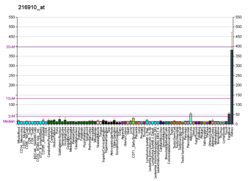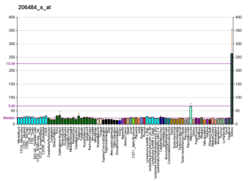XPNPEP2
Xaa-Pro aminopeptidase 2 is an enzyme that in humans is encoded by the XPNPEP2 gene.[5][6][7]
Aminopeptidase P is a hydrolase specific for N-terminal imido bonds, which are common to several collagen degradation products, neuropeptides, vasoactive peptides, and cytokines. Structurally, the enzyme is a member of the 'pita bread fold' family and occurs in mammalian tissues in both soluble and GPI-anchored membrane-bound forms. A membrane-bound and soluble form of this enzyme have been identified as products of two separate genes.[7]
References
- 1 2 3 GRCh38: Ensembl release 89: ENSG00000122121 - Ensembl, May 2017
- 1 2 3 GRCm38: Ensembl release 89: ENSMUSG00000037005 - Ensembl, May 2017
- ↑ "Human PubMed Reference:".
- ↑ "Mouse PubMed Reference:".
- ↑ Venema RC, Ju H, Zou R, Venema VJ, Ryan JW (Dec 1997). "Cloning and tissue distribution of human membrane-bound aminopeptidase P". Biochim Biophys Acta. 1354 (1): 45–8. doi:10.1016/s0167-4781(97)00126-7. PMID 9375790.
- ↑ Sprinkle TJ, Stone AA, Venema RC, Denslow ND, Caldwell C, Ryan JW (Apr 1999). "Assignment of the membrane-bound human aminopeptidase P gene (XPNPEP2) to chromosome Xq25". Genomics. 50 (1): 114–6. doi:10.1006/geno.1998.5302. PMID 9628831.
- 1 2 "Entrez Gene: XPNPEP2 X-prolyl aminopeptidase (aminopeptidase P) 2, membrane-bound".
Further reading
- Vanhoof G, De Meester I, Goossens F, et al. (1992). "Kininase activity in human platelets: cleavage of the Arg1-Pro2 bond of bradykinin by aminopeptidase P". Biochem. Pharmacol. 44 (3): 479–87. doi:10.1016/0006-2952(92)90439-P. PMID 1510698.
- Cottrell GS, Hyde RJ, Hooper NM, Turner AJ (1998). "The cloning and functional expression of human pancreatic aminopeptidase P". Biochem. Soc. Trans. 26 (3): S248. PMID 9765967.
- Dias Neto E, Correa RG, Verjovski-Almeida S, et al. (2000). "Shotgun sequencing of the human transcriptome with ORF expressed sequence tags". Proc. Natl. Acad. Sci. U.S.A. 97 (7): 3491–6. doi:10.1073/pnas.97.7.3491. PMC 16267. PMID 10737800.
- Prueitt RL, Ross JL, Zinn AR (2000). "Physical mapping of nine Xq translocation breakpoints and identification of XPNPEP2 as a premature ovarian failure candidate gene". Cytogenet. Cell Genet. 89 (1–2): 44–50. doi:10.1159/000015560. PMID 10894934.
- Strausberg RL, Feingold EA, Grouse LH, et al. (2003). "Generation and initial analysis of more than 15,000 full-length human and mouse cDNA sequences". Proc. Natl. Acad. Sci. U.S.A. 99 (26): 16899–903. doi:10.1073/pnas.242603899. PMC 139241. PMID 12477932.
- Fu GK, Wang JT, Yang J, et al. (2005). "Circular rapid amplification of cDNA ends for high-throughput extension cloning of partial genes". Genomics. 84 (1): 205–10. doi:10.1016/j.ygeno.2004.01.011. PMID 15203218.
- Suzuki Y, Yamashita R, Shirota M, et al. (2004). "Sequence comparison of human and mouse genes reveals a homologous block structure in the promoter regions". Genome Res. 14 (9): 1711–8. doi:10.1101/gr.2435604. PMC 515316. PMID 15342556.
- Gerhard DS, Wagner L, Feingold EA, et al. (2004). "The status, quality, and expansion of the NIH full-length cDNA project: the Mammalian Gene Collection (MGC)". Genome Res. 14 (10B): 2121–7. doi:10.1101/gr.2596504. PMC 528928. PMID 15489334.
- Ross MT, Grafham DV, Coffey AJ, et al. (2005). "The DNA sequence of the human X chromosome". Nature. 434 (7031): 325–37. doi:10.1038/nature03440. PMC 2665286. PMID 15772651.
- Molinaro G, Duan QL, Chagnon M, et al. (2007). "Kinin-dependent hypersensitivity reactions in hemodialysis: metabolic and genetic factors". Kidney Int. 70 (10): 1823–31. doi:10.1038/sj.ki.5001873. PMID 17003818.
This article is issued from
Wikipedia.
The text is licensed under Creative Commons - Attribution - Sharealike.
Additional terms may apply for the media files.





